A perennial subshrub plant, hyssop, blooming with purple, blue, white, pink or blue flowers from June to October, few know. But this unique ornamental plant has many medicinal properties. Hyssop or blue St. John's wort has a strong spicy aroma and is an excellent honey plant.
An unpretentious, winter-hardy, drought-resistant shrub can be grown in almost any region of our country.
Content
Features of hyssop, photos and varieties
Blue St. John's wort reaches a height of 50–70 cm and has many erect tetrahedral shoots branching from below. Opposite small leaves of the plant are dark green... Young shoots are green at first, eventually turn brown from below.
Small hyssop flowers are located on the upper part of the bush in the leaf axils. The result is a long spike-shaped inflorescence. The long decorative effect of the plant is preserved due to the fact that the flowering is stretched. Flowers do not open all at once, but gradually. To prolong the flowering of blue St. John's wort until the very frost, you can cut off the faded inflorescences. In this case, the bush will branch out and form new buds.
After flowering, yellowing bolls with small, dark brown nuts-seeds are formed on the plant. Their germination capacity lasts for three to four years.
There are over forty-five types of hyssop. The most popular varieties are:
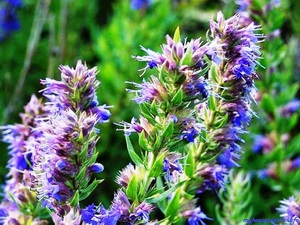 Anise blue St. John's wort. The plant grows up to 80 cm and is distinguished by beautiful leaves with brown-purple markings. Each branch of the shrub consists of a spike-shaped inflorescence. Aniseed hyssop blooms from July until frost. However, each flower lives no more than seven days. The plant's essential oils are used to treat colds. A perennial can also help with a hypertensive crisis, stroke, and a nervous breakdown.
Anise blue St. John's wort. The plant grows up to 80 cm and is distinguished by beautiful leaves with brown-purple markings. Each branch of the shrub consists of a spike-shaped inflorescence. Aniseed hyssop blooms from July until frost. However, each flower lives no more than seven days. The plant's essential oils are used to treat colds. A perennial can also help with a hypertensive crisis, stroke, and a nervous breakdown.- Hyssop officinalis grows to 55 cm. It is distinguished by a woody root system and blue flowers. Each stem of the plant is strewn with dark green leaves with drooping edges. Small flowers are located in the axils of these leaves. The shrub blooms from July to September. The medicinal blue St. John's wort is widely used in folk medicine for the treatment of respiratory tract and skin diseases.
Features of growing hyssop
For good growth, the plant is planted in sunny areas. The shrub will not bloom in the shade. Hyssop secretes tannins, so it is not recommended to place it next to vegetable crops.
Planting blue St. John's wort
The plant is undemanding to soils, however, acidic soil needs to be limed. It is recommended to dig up the land for planting hyssop in the fall. At the same time, the soil is cleared of weeds and fertilized:
- rotted manure;
- potassium salt;
- superphosphate.
If it was not possible to prepare the soil in the fall, then in the spring one glass of wood ash should be poured for each square meter of land.
Care
Hyssop is a winter-hardy, drought-resistant plant., so its cultivation will not be difficult. During the active growth of the plant, several easy rules must be observed:
 The bushes are watered as needed. In this case, you need to ensure that water does not stagnate in the soil. Otherwise, the roots of the plant may start to rot.
The bushes are watered as needed. In this case, you need to ensure that water does not stagnate in the soil. Otherwise, the roots of the plant may start to rot.- It is regularly recommended to weed under the bushes and loosen the ground.
- You need to feed the plant with mineral fertilizers at the rate of 2 tbsp. l. for 10 liters of water. It is better not to feed hyssop with fresh manure. Otherwise, it will lose its flavor.
- During full flowering, young shoots are cut off. Pruning should be done 2-3 times during the summer.
- Do not allow self-seeding of blue St. John's wort grown as a medicinal raw material. To do this, the shoots must be cut off even before the seeds ripen, and the ground under the bush must be carefully weeded.
- In autumn, the bushes are cut to a height of 10-15 cm. This contributes to the formation of a dense crown of the bush for the next year, and abundant flowering.
- You don't need to cover the hyssop for the winter.
- Due to its aromatic odor, the plant is practically not damaged by pests.
It is recommended to rejuvenate hyssop that has been growing in one place for more than five years by dividing the root system.
Propagation of hyssop
The shrub reproduces in three ways:
- cuttings;
- dividing the bush;
- sowing seeds.
Dividing the bush
This is the easiest way to reproduce. For this bushes are dug up in spring and are separated. The resulting plots are slightly deepened when planting and are well watered.
Experienced gardeners know an even easier way to reproduce hyssop in this way.
- In autumn, the lower part of all the shoots of the bush is covered with fertile soil.
- The plant is watered periodically.
- In the spring, roots should grow on each shoot.
- The bush itself can not be dug out, but simply separate the shoots and plant them half a meter apart.
Cuttings
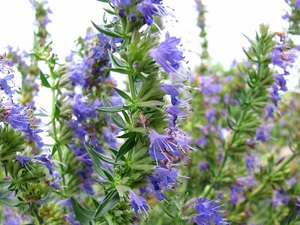 You can root cuttings from spring to late summer. The segments should be 10 cm long, and land in a prepared earthen mixture consisting of sand and peat... You can plant them in garden soil, but in this case, the cuttings will take root worse.
You can root cuttings from spring to late summer. The segments should be 10 cm long, and land in a prepared earthen mixture consisting of sand and peat... You can plant them in garden soil, but in this case, the cuttings will take root worse.
For faster rooting, cuttings can be covered with glass or plastic wrap. The plantings need to be regularly moistened and made sure that they are not exposed to direct sunlight.
Growing hyssop from seeds
Shrub seeds are planted in open ground before winter, or sown for seedlings in spring.
Hyssop seeds are harvested during the browning period, shortly before they ripen. The inflorescences are cut off and laid out on paper for a while. Over time they need to be hung upside down... Ripe seeds will begin to spill out.
When planting seeds for seedlings, sowing is done in March.
- The seeds must be mixed with sand, cover the seedling container with plastic or glass and put in a warm place.
- When two true leaves appear, the senses dive into separate pots.
- Approximately at the end of May, when the soil has already warmed up, and the seedlings will have 5–6 true leaves, they can be planted in a permanent place in open ground.
- The distance between young plants should be 25–35 cm.
- The seedlings are buried no more than 5–10 cm. The growing point should be on the surface.

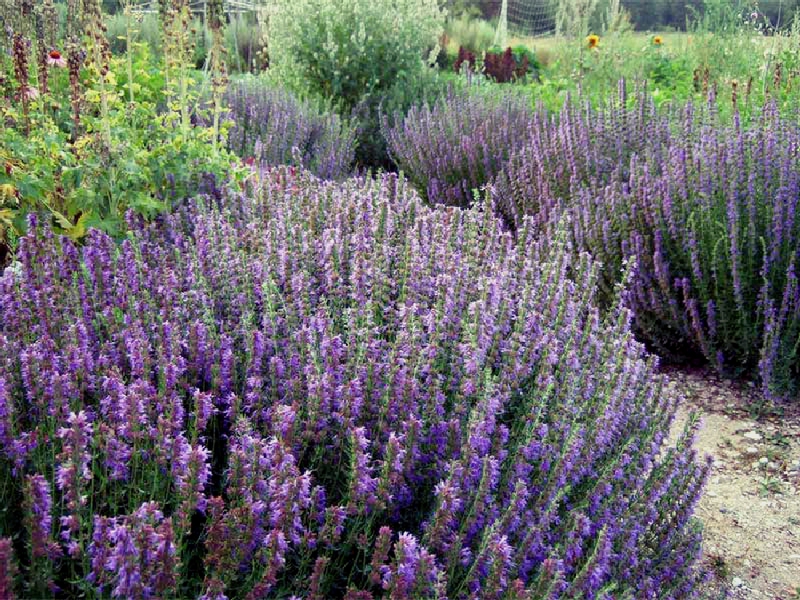
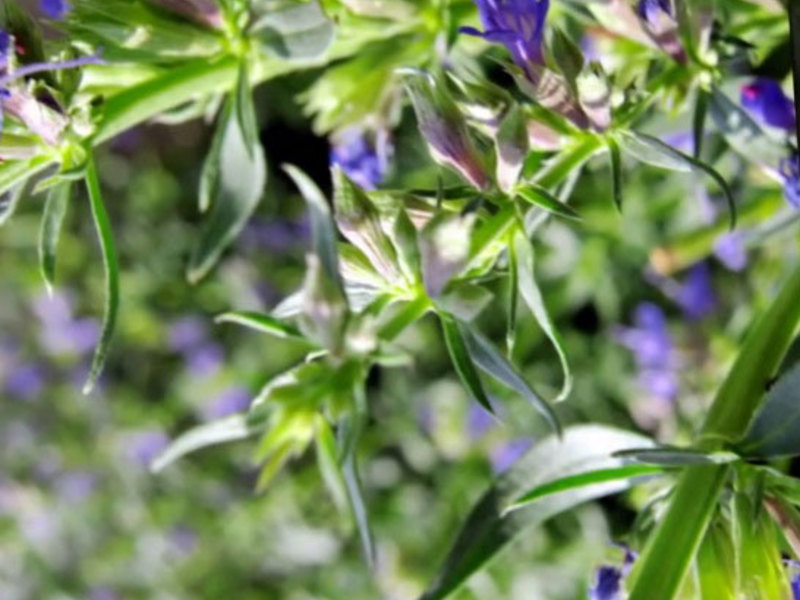
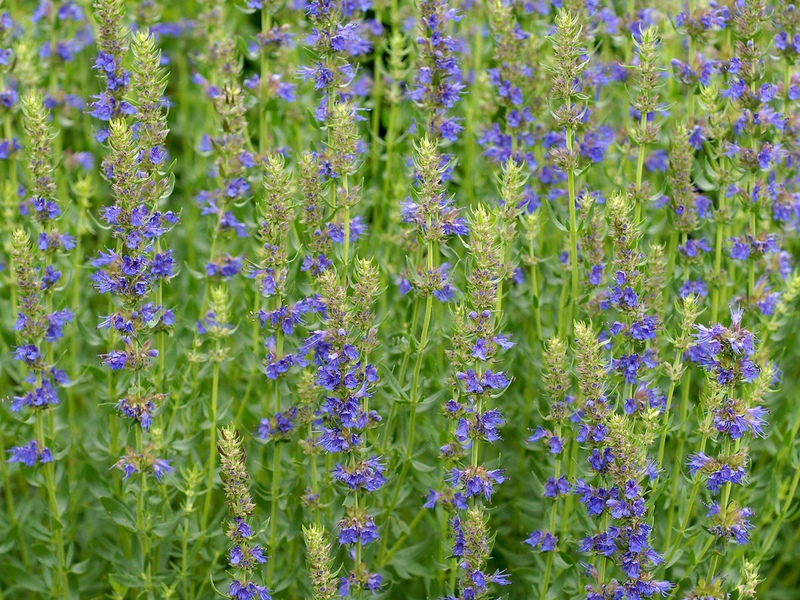
From sowing seeds for seedlings to planting young plants in open ground, it takes about 50-60 days.
Blue St. John's wort can be planted directly into open ground. For this, the soil is dug up and fertilized. Then furrows are made in it, into which seeds mixed with sand are sown... From above, the crops are sprinkled with soil no more than 1 cm thick.
So that when watering, a crust does not form on the soil, and it does not wash out, it is recommended to cover the crops from above with mulch. Seeds sown before winter cannot be mulched. Otherwise, you can provoke damping.
At a temperature of + 2C, the seeds will begin to hatch, and in about two weeks the first shoots will appear.
Hyssop use
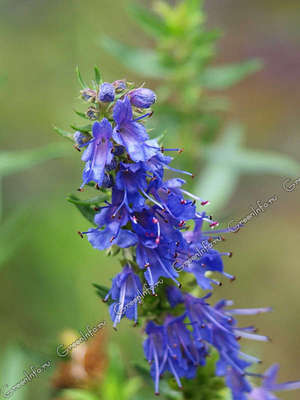 Even in ancient times, monks used shrubs to cleanse temples. Bunches of plants were hung all over the room.
Even in ancient times, monks used shrubs to cleanse temples. Bunches of plants were hung all over the room.
Hyssop was used to purify the air and drive out lice. It was used in the manufacture of wines and added to liqueurs.
Currently, decoctions and infusions are prepared from the plant, which are used to treat:
- wounds;
- bruising;
- bruises;
- eczema;
- skin irritation;
- herpes;
- burns;
- abscesses.
Lotions from decoctions can help bruises quickly dissolve, and wounds heal.
Hyssop infusions treat inflammation in the throat. They are used for coughs and high fever. They are often used as a diuretic, carminative and expectorant... With the help of infusions, they get rid of sweating and intestinal parasites. They normalize digestion and eliminate the effects of a hangover.
For the treatment of colds and bronchitis, tea is brewed from hyssop:
- Fresh grass is finely chopped.
- Pour 250 ml of cold water over two teaspoons.
- Bring to a boil and leave for five minutes.
 You can have the same amount, but dry herbs, just brew with a glass of boiling water, and let it brew for no more than 15 minutes. Apply 100 grams five times a day.
You can have the same amount, but dry herbs, just brew with a glass of boiling water, and let it brew for no more than 15 minutes. Apply 100 grams five times a day.
Hyssop compress is prepared from thirty grams of dry grass and five hundred milliliters of boiling water. Infused for fifteen minutes... A clean gauze or napkin soaked in the infusion is applied to the sores or chest.
The use of decoctions and infusions from hyssop is contraindicated:
- pregnant and lactating mothers;
- children under two years old;
- patients with epilepsy;
- hypertensive patients.
Blue St. John's wort in cooking
A wonderful spice that whets your appetite is the hyssop plant. The tops of young shoots are used as a seasoning during the blooming of the first flowers. You need to cut them off with leaves of inflorescences and buds.
The dried and freshly fragrant greens of the plant can be used to add flavor to dishes made from beans, meat, fish, vegetables. Piquant taste will add hyssop to processed cheese or cottage cheese. Greens can be used to make alcoholic drinks and vinegar fragrances.
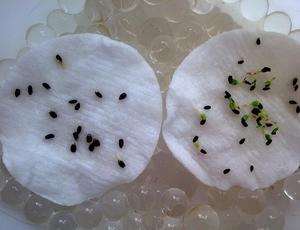 The plant is very useful for digestion. It has a mild laxative effect and helps break down dietary fats.
The plant is very useful for digestion. It has a mild laxative effect and helps break down dietary fats.
In the garden, hyssop can be grown in single or group plantings. It will look good along paths, in a rockery among stones or in a flower bed among spicy herbs. In addition, an unpretentious shrub to grow can be used for cooking and medicinal purposes... The plant can be a great reason to start beekeeping, as this very strong honey plant is literally sticking to the bees.


